1. General introduction to Long Doi Son Pagoda
1.1. Where is Long Doi Son Pagoda, how far is it from Hanoi, and how convenient is the way to get there?
Long Doi Son Pagoda is located on the top of Doi mountain in Tien Son ward, Ninh Binh. From the mountaintop, visitors can admire the panoramic view of the Duy Tien marshland region with its lush green rice fields, cornfields, and potato fields, creating a peaceful and poetic scene.
At the foot of the mountain, the Chau Giang river winds like a soft silk ribbon. Around the foot of the mountain, there are also 9 natural wells, which local people liken to "nine dragon eyes". To reach the pagoda, visitors must climb nearly 373 stone steps. The pagoda is situated in a picturesque landscape of mountains and water, offering a quiet and peaceful atmosphere.
1.2. Cultural and historical value: Special National Monument, architectural heritage of the Ly dynasty nearly 1,000 years old
The Long Doi Son Pagoda monument, recognized as a Special National Monument, is a precious architectural and historical heritage of the Ly dynasty nearly 1,000 years old. The pagoda was built during the reign of King Ly Thanh Tong and Queen Y Lan, and later King Ly Nhan Tong continued its development, building the Sung Thien Dien Linh tower. This complex of monuments not only has historical value but also carries great spiritual significance.
Notably, Long Doi Son Pagoda still preserves many valuable artifacts, most notably the Sung Thien Dien Linh stele, a brilliant Buddhist relic of the Ly dynasty, recognized as a National Treasure. The stele records the merits of King Ly Nhan Tong, Grand Tutor Ly Thuong Kiet, and the state of Buddhism during the Ly dynasty. Long Doi Son Pagoda was recognized as a National Cultural and Historical Monument in 1992 and a Special National Monument in 2017, affirming the pagoda's position and value in Vietnamese culture.
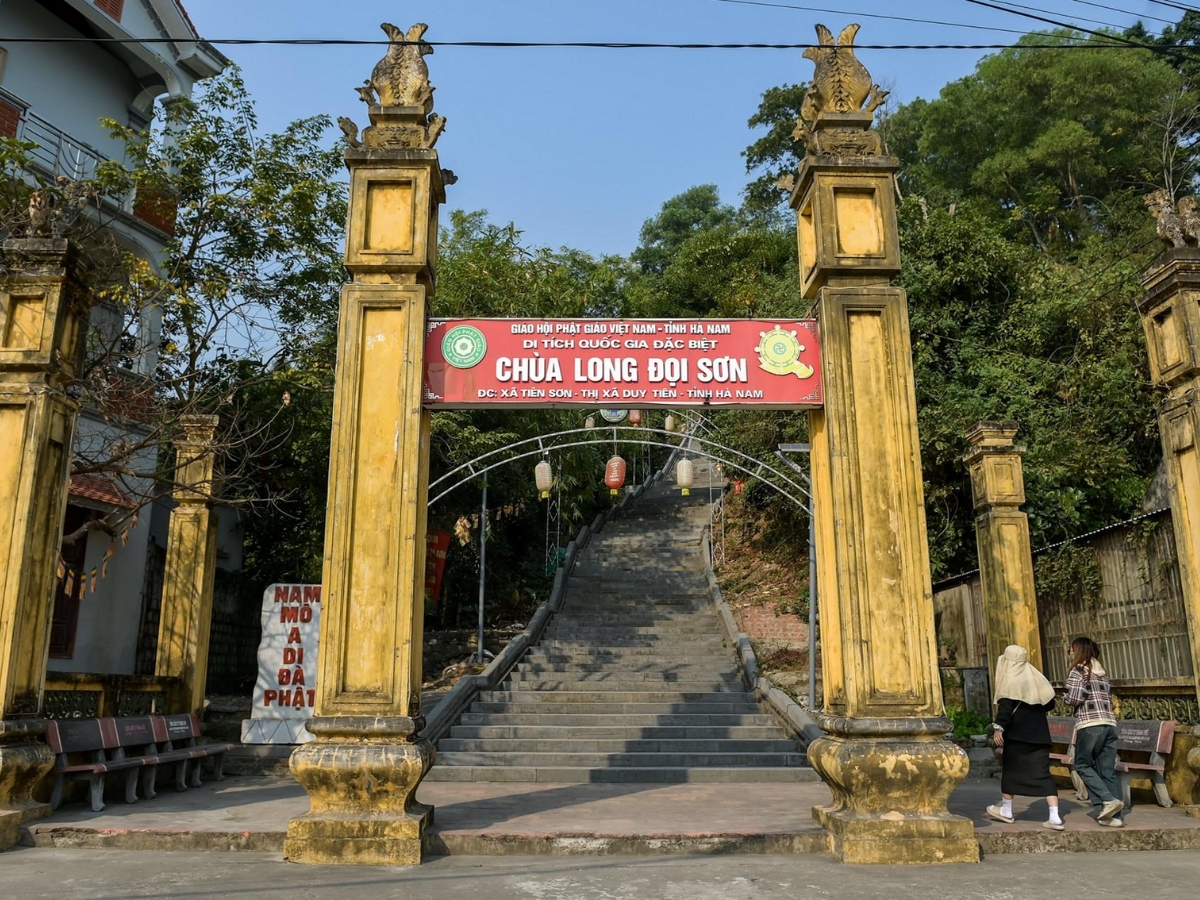
Long Doi Son Pagoda was recognized as a Special National Monument in 2017. (Source: Vietnamnet)
2. Guide to traveling to Long Doi Son Pagoda in 2025
2.1. From Hanoi to Long Doi Son Pagoda
Regarding transportation and routes, you can depart from Hanoi by motorbike, private car, or bus. The most convenient route is via the Cau Gie – Ninh Binh expressway, turn at the Vuc Vong intersection, and continue along National Highway 38 straight to Doi Son commune.
The estimated travel time is from 1 to 1.5 hours, depending on traffic at the time of departure. If you choose a bus from Hanoi to Phu Ly, the one-way ticket price is usually from 60,000 to 90,000 VND. With a motorbike, travel will be more flexible, suitable for those who like to proactively visit stops along the way.
You should depart early to avoid traffic jams and have more time to experience. The route is not too difficult, however, on the section entering the village and the small paths leading up to the pagoda, you should prepare a digital map or GPS for convenience.
2.2. From Ho Chi Minh City and other regions to Long Doi Son Pagoda
If departing from Ho Chi Minh City or distant provinces, you can fly to Noi Bai Airport, then continue by taxi or bus to Phu Ly. Additionally, the North-South train route with a stop at Phu Ly station is also a convenient option.
From Phu Ly station or bus station, you can take a taxi for a cost of 80,000 to 120,000 VND directly to Long Doi Son Pagoda. Additionally, intra-provincial bus routes also support travel, however, you need to research the route and the most convenient stop near the pagoda beforehand.
2.3. Traveling within Ha Nam province to Long Doi Son Pagoda
Popular options include taxi, bus, or motorbike rental from the center of Phu Ly. Taxi services here are quite common and reasonably priced. If you prefer to explore freely, you can rent a motorbike from shops around the train station or bus station.
The final stretch up Doi mountain is a small village path through peaceful hamlets with rustic houses on both sides of the road. Near the pagoda are stone steps leading to the summit, this section is suitable for walking, allowing you to feel the fresh air and admire the serene natural scenery.
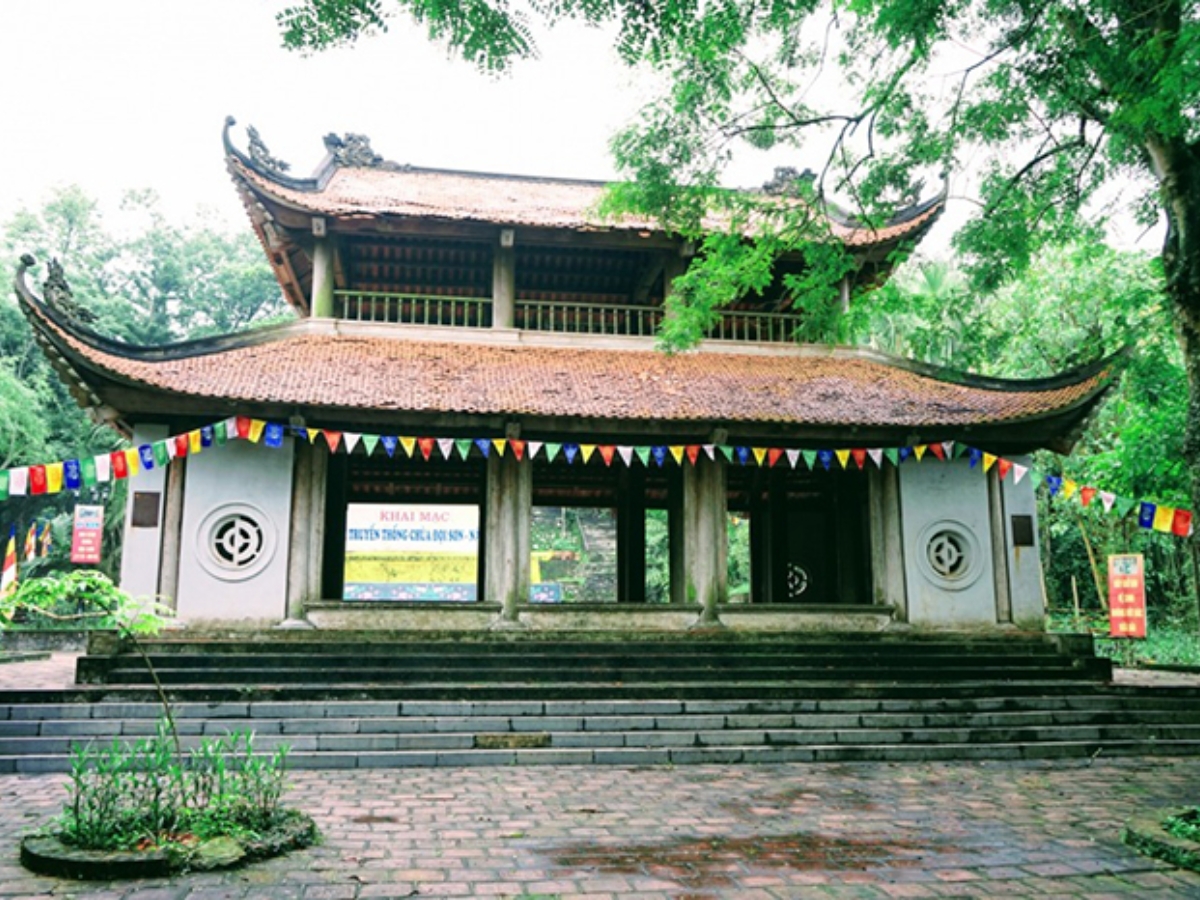
Serene and cool scenery at the pagoda. (Source: Collected)
3. History of formation and development of Long Doi Son Pagoda
The nearly thousand-year history of Long Doi Son Pagoda is associated with many ups and downs of the nation, from the prosperous period under the Ly dynasty to resilient reconstructions during wartime. Each period leaves its own mark on the pagoda's architecture and relics.
3.1. Construction events during the Ly dynasty, the imprint of Kings Ly Thanh Tong and Ly Nhan Tong
The Long Doi Son Pagoda was commenced during the reign of King Ly Thanh Tong in 1054 under the supervision of Queen Mother Y Lan. At that time, Buddhism was spreading strongly in Dai Viet; the Ly kings as well as the royal family frequently built pagodas and promoted Buddhism.
In 1118, under the reign of King Ly Nhan Tong, the pagoda was chosen to build the Sung Thien Dien Linh stupa – completed in 1121, becoming a typical Buddhist center for the entire Son Nam region. This important event is also deeply recorded on the Sung Thien Dien Linh stone stele, an artifact still perfectly preserved at the pagoda.
3.2. Destructions and reconstructions through the ages
Over many centuries, Long Doi Son Pagoda was destroyed many times. In the 15th century, during the Ming invasion, the pagoda and its stupa were almost completely destroyed, and many valuable artifacts were lost. However, the resilient spirit of the local people helped the structure to be revived soon.
The Later Le, Mac, and Nguyen dynasties all paid attention to restoring and expanding the pagoda. Especially during the Nguyen dynasty, the pagoda was renovated on a scale of over 100 bays in the beautiful 'noi cong ngoai quoc' style. In 1947, during the resistance war against the French, the pagoda was further affected, but in 1957 it was restored and has been continuously repaired to this day.
The preservation of the relic through the dynasties affirms the pagoda's key religious and cultural role for the Ha Nam community as well as the North. The perseverance in conservation also reflects the reverence and deep historical significance that Long Doi Son Pagoda brings to the nation.

Historical imprints are still clearly engraved at the pagoda. (Source: Collected)
4. Architecture and Precious Artifacts at Long Doi Son Pagoda
Upon passing through the gate of Long Doi Son Pagoda, visitors will be impressed by the harmonious combination of traditional architecture and pristine nature. Each construction item, each ancient artifact here, holds unique artistic and spiritual values of our ancestors.
4.1. Overall Architecture, Grounds, Tam Quan, and Stupa Garden
The overall architecture of Long Doi Son Pagoda bears characteristics of many eras, reflecting a long process of restoration and development. The pagoda covers an area of over 10,000m2, with its largest restoration during the Nguyen Dynasty, expanding its scale to over 100 large and small compartments. The overall architecture of the pagoda is designed in the "noi cong ngoai quoc" style, creating a space that is both imposing and solemn, yet harmonious with nature. The structures include the Tam Quan, Tam Bao, ancestral house, and many other sections, demonstrating the intermingling and inheritance of traditional architectural values.
The Quan Am statue and the Lieu Mau shrine are harmoniously arranged, enriching the multi-layered spiritual space. The Tam Quan opens to a spacious pagoda courtyard – where ancient artifacts are displayed, creating a harmony between people and the scenery.
4.2. Sung Thien Dien Linh Stupa
Sung Thien Dien Linh Stupa, built from 1118–1121, once stood 13 stories high, serving as a typical symbol of Ly Dynasty Buddhist architecture. Despite undergoing upheavals, the original stupa no longer exists, but the large Sung Thien Dien Linh stone stele is preserved intact.
On the stele are carved lines depicting flying dragons and characteristic patterns, reaching the peak of Ly Dynasty sculptural art. This stone stele was commissioned by King Ly Nhan Tong himself and is recognized as a National Treasure.
4.3. Outstanding Relics and Ancient Artifacts
The large bronze Maitreya Buddha statue located in the main hall is a precious artifact preserved from the Ly Dynasty. The statue is crafted in a classical style, distinguished by its benevolent and friendly countenance, deeply conveying the Buddhist concept of compassion.
Additionally, a set of 6 Vajrapani statues, 1.6m tall, along with many remaining stone works, hold significant archaeological and aesthetic value. These ancient artifacts are the result of the development of Ly Dynasty sculptural art, reflecting the combination of skillful techniques and profound spiritual content.
This collection of relics is not only important for preserving Buddhist identity but also serves as a valuable source of research material for ancient Vietnamese art and culture.
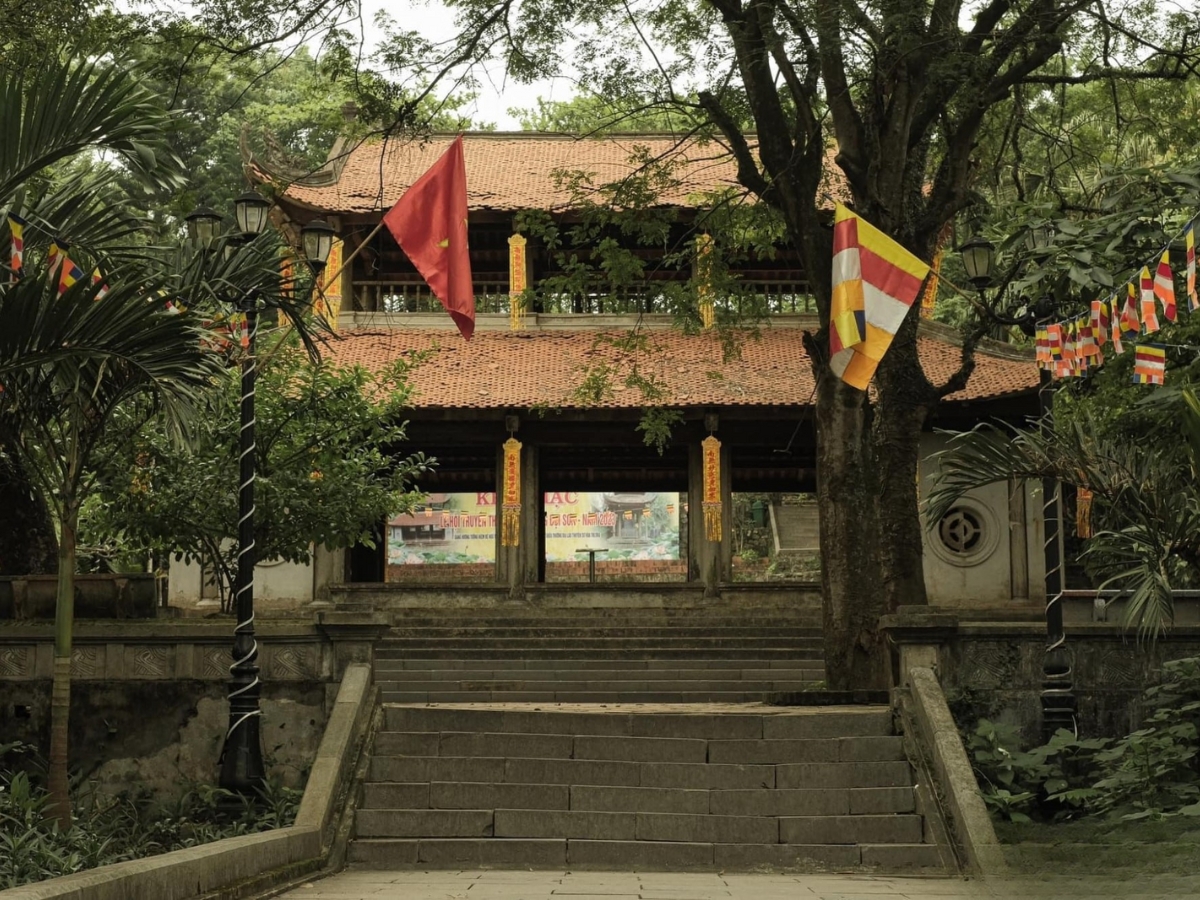 The remaining relics at the pagoda hold immense cultural and artistic value for the nation. (Source: Collected)
The remaining relics at the pagoda hold immense cultural and artistic value for the nation. (Source: Collected)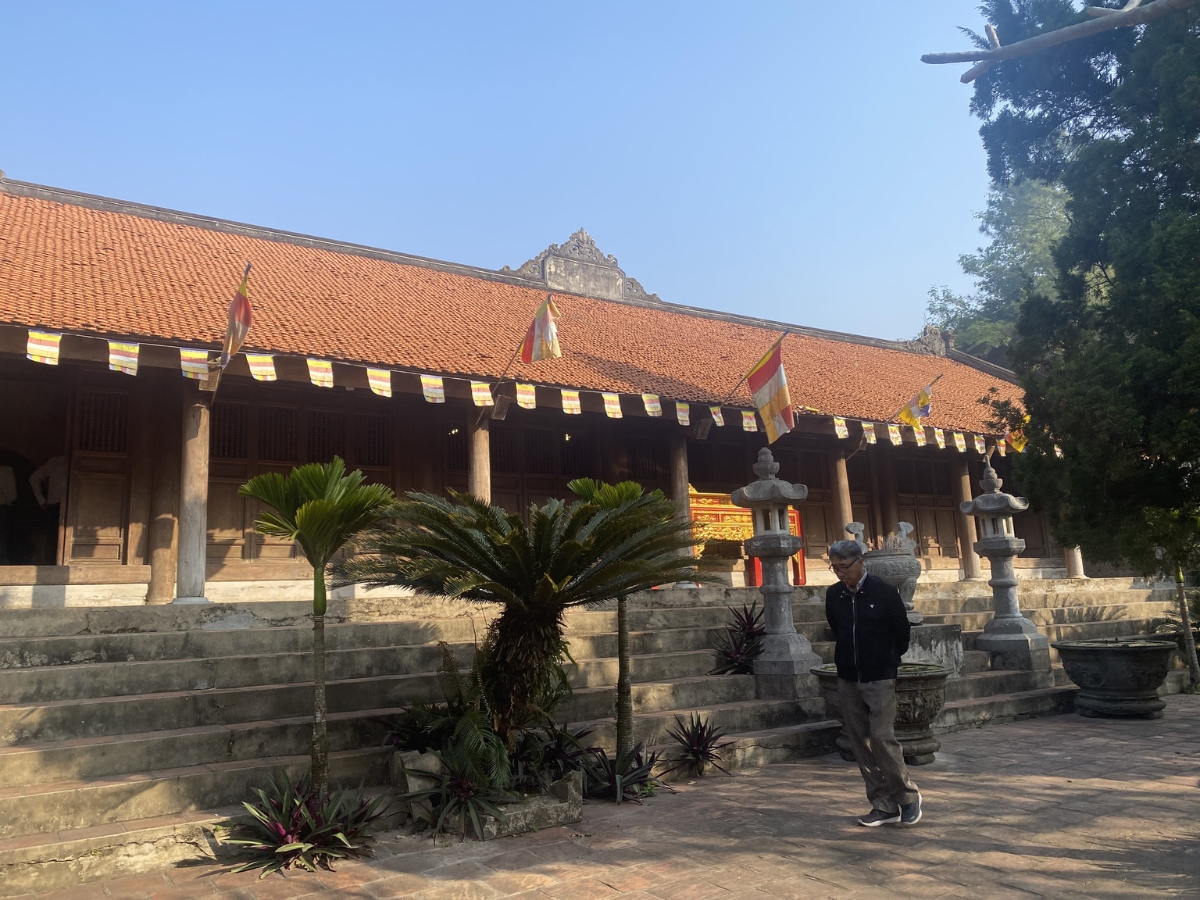
Visit Long Doi Son Pagoda during the 3rd lunar month festival to enjoy a heroic and vibrant traditional festival atmosphere. (Source: Collected)
6. Tips for visiting Long Doi Son Pagoda
To make your visit to Long Doi Son Pagoda complete and meaningful, you should proactively research the ideal time, pay attention to attire, and behavior within the sacred space of the pagoda.
6.1. Best time to visit suggestions
The most suitable time to visit Long Doi Son Pagoda is during the 3rd lunar month festival season or in autumn when the weather is cool. Participating in the 3rd lunar month festival, you will feel the sacredness, vibrancy, and many unique cultural activities.
Additionally, autumn from September to November is another ideal time, with mild weather, fresh air, and new scenery. This is a suitable time for both worship and admiring the natural beauty.
On days with heavy rain, consider that the stone steps can be slippery. For a quiet experience, choose days that are not during peak early spring occasions.
6.2. Attire, behavior, and things to avoid when visiting a pagoda
When visiting Long Doi Son Pagoda, choose modest, polite attire. Do not wear short skirts, shorts, sleeveless tops, or tight clothing when entering worship areas. Wear neutral colored clothing, avoiding overly prominent patterns or those unsuitable for the spiritual space.
Within the pagoda grounds, maintain cleanliness, do not litter, do not make noise or eat/drink indiscriminately. Do not touch artifacts without permission, especially in the area displaying ancient relics and stupas.
When taking photos, be mindful not to use flash, avoid moving offerings, or disturbing Buddhist practitioners during worship. Absolutely do not climb on or sit on antiques for photos. Showing respect for the space and its cultural and spiritual values is something to remember.
6.3. Photography and check-in tips
The ideal location for taking photos at Long Doi Son Pagoda is the path of 373 stone steps with the shade of ancient trees on both sides, creating an eye-catching natural backdrop. The ancient Tam Quan gate is where many visitors want to capture moments when they visit.
The tower garden with over 200 small towers is a unique, ideal photo spot for panoramic shots. The front of the Sung Thien Dien Linh stupa, where the ancient stone stele is located, is a must-visit photo and check-in spot.
From the top of the pagoda, you can capture the vast fields below, creating photos rich in depth and emotion. Early morning or late afternoon are the two times with the best lighting, making it easy to produce impressive shots.
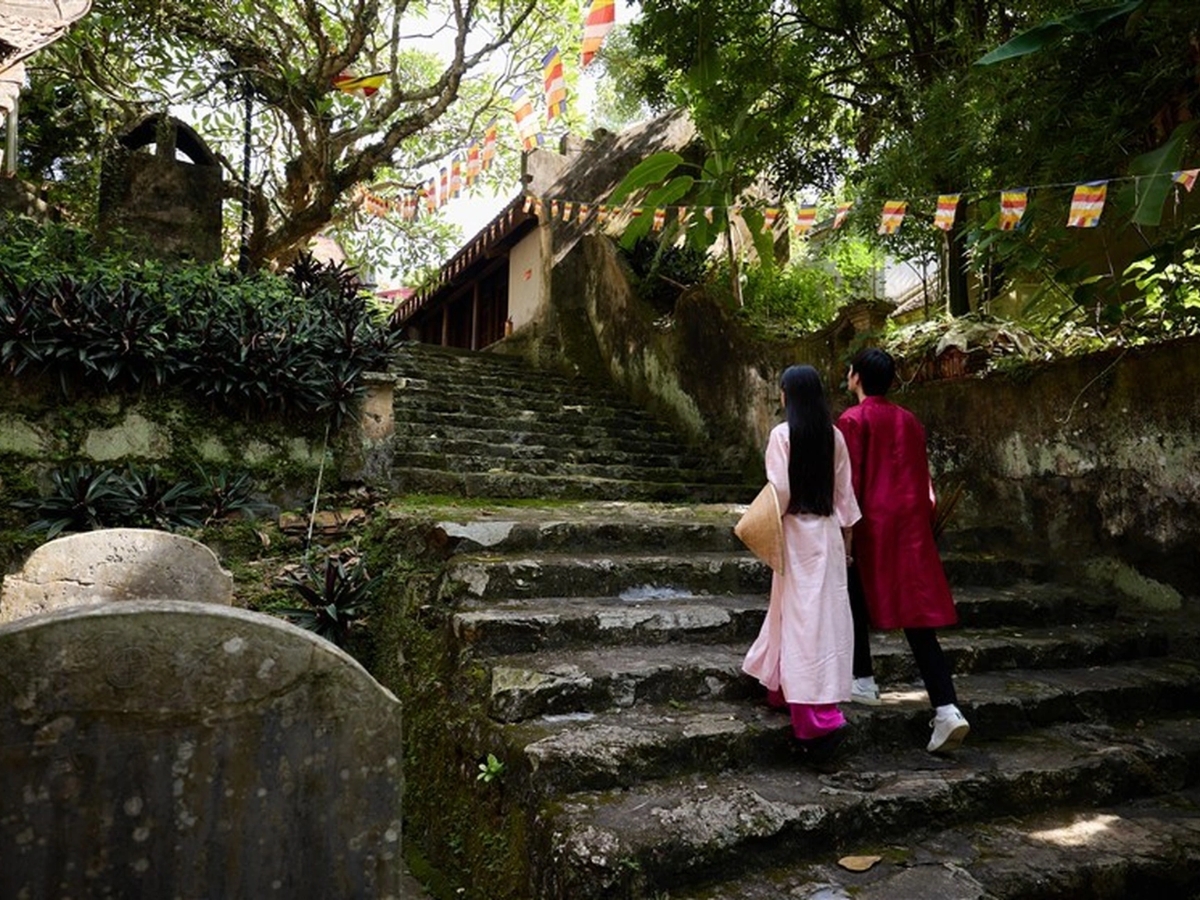
The journey of climbing 373 stone steps will surely give visitors a memorable experience. (Source: Dan Tri)
7. Suggested itinerary combining a visit to Long Doi Son Pagoda and nearby attractions
Besides Long Doi Son Pagoda, Ha Nam province has many other attractive tourist destinations. Arranging sightseeing spots reasonably will make your trip richer and save time.
7.1. Half-day – 1-day itinerary to visit the pagoda and enjoy local cuisine
In the morning, you should depart from Hanoi around 6:30 AM, arriving at Long Doi Son Pagoda when the early morning air is still fresh. The journey begins with climbing 373 stone steps to the summit, visiting the main structures, offering incense at the main hall, and admiring the Sung Thien Dien Linh stupa.
Don't forget to capture moments in the stupa garden, the ancient pathways, and the surrounding scenery of the pagoda. If you visit during a festival, try to immerse yourself in the traditional cultural activities here.
At noon, you should enjoy Ha Nam specialties such as Vu Dai village braised fish, which carries a strong rural imprint, steamed rice rolls served with Vietnamese pork sausage, or crispy and delicious fish cakes with rice crackers, full of Northern Vietnamese flavor.
In the afternoon, you can explore more traditional craft villages near the pagoda or choose to rest in the tranquil atmosphere of the pagoda, enjoying a peace rarely found elsewhere.
7.2. Combining the experience of Long Doi Son Pagoda with Sun World Ha Nam
You can combine a trip to Long Doi Son Pagoda with Sun World Ha Nam amusement park – a modern entertainment venue with harmonious landscapes, suitable for family trips. Additionally, Tam Chuc Pagoda – a major Buddhist work in Vietnam – is also very attractive to visit.
Bai Dinh Pagoda in Ninh Binh, only about 40 km from Long Doi Son Pagoda, is also a good suggestion for your spiritual journey. You can spend 2–3 days to fully explore the historical, spiritual, and simple natural landscapes.
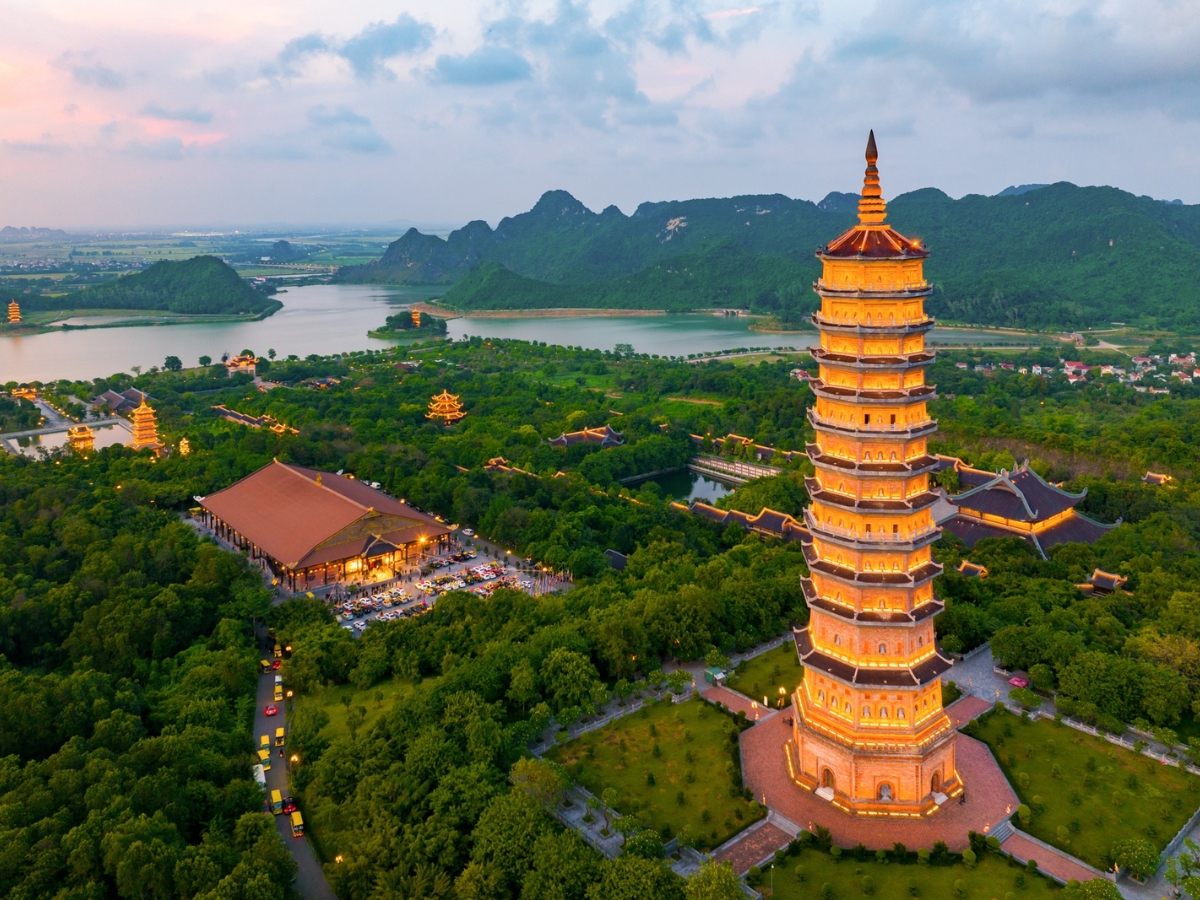
Magnificent beauty at night of Bai Dinh Pagoda. (Source: Collected)
Long Doi Son Pagoda with nearly 1,000 years of history is a living testament to the cultural, artistic, and spiritual values of Vietnamese Buddhism. The blend of Ly Dynasty architectural heritage, peaceful scenery, and sacred atmosphere at the pagoda has created a very worthwhile stopover for those who love the Northern region. Don't miss the opportunity to explore this ancient pagoda on your journey in 2025!

